Management Strategies and Collaborative Relationships for Sustainability in the Agrifood Supply Chain
Abstract
1. Introduction
2. Description of the Agrifood Chain
2.1. Examination of Horizontal and Vertical Relationships within the Chain
2.2. Management Elements for the Agrifood Supply Chain
3. Case of Study: Spanish Vegetable Supply Chain
3.1. Plans of Large Distribution as the Dominant Company
- -
- Tendency to create alliances with suppliers that favor the latter’s planning processes, making supplies more reliable.
- -
- Preference to establish contractual relationships, insofar as possible, with nearby suppliers, to develop local economies. In the case of perishables, this practice helps to favor the sale of fresh products.
- -
- Use of an intermodal transport system; a difficult undertaking, above all with highly seasonal perishable products.
- -
- Commitment to new technologies, with the aim of improving and facilitating communications between operators in the chain.
- -
- Development of initiatives intended to reduce environmental impact: carbon footprint and water footprint.
- -
- Retailer considers that problems related to safety and quality are resolved through either the implementation of independently developed protocols (e.g., Nurture in Tesco) or ones agreed upon by various members in the sector (Global Gap, Quality Scheme for safe food-QS, International Food Standard-IFS). These standards also include social aspect add-ons.
3.2. The Collaborative Response of the Agrifood Company
- (A)
- Production—Sustainability Programming:
- Medium or long-term purchase–sale optimization programs to save inputs or avoid waste.
- Actions aimed at controlling the social and environmental responsibility of your production.
- (B)
- Production—Quality and Health Programming:
- 3.
- Agreements or collaborations to improve the quality and health safety of products.
- 4.
- Collaboration to schedule production or improvement of products.
- (C)
- Transport—Sustainability:
- 5.
- Collaborations with the aim of optimizing loads (i.e., groupage).
- 6.
- Collaborations with the aim of optimizing routes or implementation of new transport systems.
- (D)
- Transport—Quality and Health:
- 7.
- Agreements or collaborations to control the quality of the product in transport
- (E)
- Facilities—Sustainability:
- 8.
- Projects to improve facilities at origin or destination with the aim of improving production sustainability.
- (F)
- Facilities—Quality and Health:
- 9.
- Projects to improve facilities at origin or destination with the aim of improving production quality and health.
3.3. Influence of Collaboration on the Results
4. Discussion and Conclusions
Author Contributions
Funding
Institutional Review Board Statement
Informed Consent Statement
Data Availability Statement
Conflicts of Interest
References
- Varma, S.; Wadhwa, S.; Deshmukh, S. Implementing supply chain management in a firm: Issues and remedies. Asia Pac. J. Mark. Logist. 2006, 18, 223–243. [Google Scholar] [CrossRef]
- Ralston, P.M.; Blackhurst, J.; Cantor, D.E.; Crum, M.R. A structure-conduct performance perspective of how strategic supply chain integration affects firm performance. J. Supply Chain Manag. 2015, 51, 47–64. [Google Scholar] [CrossRef]
- Franco, R.P.; Phadnis, S.; Caplice, C.; Sheffi, Y. Rethinking supply chain strategy as a conceptual system. Int. J. Prod. Econ. 2016, 182, 384–396. [Google Scholar] [CrossRef]
- Kwok, S.K.; Wu, K.K.W. RFID-based intra-supply chain in textile industry. Ind. Manag. Data Syst. 2009, 109, 1166–1178. [Google Scholar] [CrossRef]
- Qi, Y.; Huo, B.; Wang, Z.; Yeung, H.Y.J. The impact of operations and supply chain strategies on integration and performance. Int. J. Prod. Econ. 2017, 185, 162–174. [Google Scholar] [CrossRef]
- Yusuf, Y.Y.; Gunasekaran, A.; Adeleye, E.O.; Sivayoganathan, K. Agile supply chain capabilities: Determinants of competitive objectives. Eur. J. Oper. Res. 2004, 159, 379–392. [Google Scholar] [CrossRef]
- Kotzab, H.; Skjoldager, N.; Vinum, T. The development and empirical validation of an e-based supply chain strategy optimization model. Ind. Manag. Data Syst. 2004, 103, 347–360. [Google Scholar] [CrossRef]
- Mazzarol, T. Co-Operative Enterprise. A Discussion Paper & Literature Review; Co-Operatives: Perth, WA, Australia, 2009. [Google Scholar]
- Lyons, A.C.; Ma’aram, A. An examination of multi-tier supply chain strategy alignment in the food industry. Int. J. Prod. Res. 2014, 52, 1911–1925. [Google Scholar] [CrossRef]
- Flynn, B.; Huo, B.; Zhao, X. The impact of supply chain integration on performance: A contingency and configuration approach. J. Oper. Manag. 2010, 28, 58–71. [Google Scholar] [CrossRef]
- Fischer, C.; Hartmann, M.; Reynolds, N.; Leat, P.; Giha, C.R.; Henchion, M.; Albisu, L.M.Y.; Gracia, A. Factors influencing contractual choice and sustainable relationships in European agrifood supply chains. Eur. Rev. Agric. Econ. 2010, 36, 541–569. [Google Scholar] [CrossRef]
- Mesa, J.C.P.; Gómez, E.G. Collaborative firms managing perishable products in a complex supply network: An empirical analysis of performance. Supply Chain Manag. Int. J. 2015, 20, 128–138. [Google Scholar] [CrossRef]
- Arzu, G.; Erman, T. Supply chain performance measurement: A literature review. Int. J. Prod. Res. 2002, 48, 5137–5155. [Google Scholar] [CrossRef]
- Gómez, E.G.; Mesa, J.C.P.; Sánchez, J.A. Internationalisation of SMEs and simultaneous strategies of cooperation and competition: An exploratory analysis. J. Bus. Econ. Manag. 2017, 17, 1114–1132. [Google Scholar] [CrossRef]
- Dobson, P.; Waterson, M.; Davies, S.W. The patterns and implications of increasing concentration in European food retailing. J. Agric. Econ. 2013, 54, 111–125. [Google Scholar] [CrossRef]
- Hingley, M. Power imbalance in UK agrifood supply channels: Learning to live with the supermarkets? J. Mark. Manag. 2005, 21, 63–88. [Google Scholar] [CrossRef]
- Brandenburger, A.M.; Nalebuff, B.J. Co-Opetition; Doubleday: New York, NY, USA, 1996. [Google Scholar]
- Dagnino, G.B.; Mariani, M. Co-Opetitive Value Creation in Entrepreneurial Contexts: An Applied Interpretative Framework. In Co-Opetition: Winning Strategies for the 21st Century; Yami, S., Castaldo, S., Dagnino, G.B., Roy, F.L., Czakon, W., Eds.; Edward Elgar: Cheltenham, UK, 2010; pp. 101–123. [Google Scholar]
- Zerbini, F.; Castaldo, S. Stay in or get out the Janus? The maintenance of multiplex relationship between buyers and sellers. Ind. Mark. Manag. 2007, 36, 941–954. [Google Scholar] [CrossRef]
- Wilhelm, M.M. Managing co-opetition through horizontal supply chain relations: Linking dyadic and network levels of analysis. J. Oper. Manag. 2011, 29, 663–676. [Google Scholar] [CrossRef]
- Pérez, A.M.G.; Cervantes, C.R.; Martínez, M.G. De la cooperativa agroalimentaria a la learning netchain. Hacia un planteamiento teórico interorganizativo e interpersonal. REVESCO Rev. Estud. Coop. 2016, 121, 114–144. [Google Scholar]
- Lazzarini, S.; Chaddad, F.; Cook, M. Integrating supply chain and network analyses: The study of netchains. J. Chain Netw. Sci. 2001, 1, 7–22. [Google Scholar] [CrossRef]
- Yu, S.; Park, J.E.; Min, S. Factors of determining long-term orientation in interfirm relationships. J. Bus. Res. 2007, 60, 1225–1233. [Google Scholar]
- Gurnani, H.; Erkoc, M.; Luo, Y. Impact of product pricing and timing of investment decisions on supply chain co-opetition. Eur. J. Oper. Res. 2007, 180, 228–248. [Google Scholar] [CrossRef]
- Droge, C.; Vickery, S.K.; Jacobs, M.A. Does supply chain integration mediate the relationships between product/process strategy and service performance? An empirical study. Int. J. Prod. Econ. 2009, 137, 250–262. [Google Scholar] [CrossRef]
- Rong, A.; Akkerman, R.; Grunow, M. An optimization approach for managing fresh food quality throughout the supply chain. Int. J. Prod. Econ. 2011, 131, 421–429. [Google Scholar] [CrossRef]
- Wassermann, S.; Faust, K. Social Network Analysis: Methods and Applications; Cambridge University Press: Cambridge, UK, 1994. [Google Scholar]
- Rice, J.B.; Hope, R.M. Supply chain vs. Supply chain: The hype and the reality. Supply Chain Manag. Rev. 2011, 5, 47–54. [Google Scholar]
- Peterson, C. The Learning Supply Chain: Pipeline or Pipedream? Am. J. Agric. Econ. 2002, 84, 1329–1336. [Google Scholar] [CrossRef]
- Fawcett, S.E.; Magnan, G.M.; Mccarter, M.W. Benefits, barriers, and bridges to effective supply chain management. Supply Chain Manag. Int. J. 2008, 13, 35–48. [Google Scholar] [CrossRef]
- Choi, T.Y.; Hong, Y. Unveiling the structure of supply networks: Case studies in Honda, Acura, Daimler Chrysler. J. Oper. Manag. 2002, 20, 469–493. [Google Scholar] [CrossRef]
- Wu, Z.; Choi, T.; Rungtusanatham, M.J. Supplier–supplier relationships in buyer–supplier–supplier triads: Implications for supplier performance. J. Oper. Manag. 2010, 28, 115–123. [Google Scholar] [CrossRef]
- Yu, M.; Nagurney, A. Competitive food supply chain networks with application to fresh produce. Eur. J. Oper. Res. 2012, 224, 273–282. [Google Scholar] [CrossRef]
- Badole, C.M.; Jain, D.R.; Rathore, D.A.; Nepal, D.B. Research and Opportunities in Supply Chain Modelling: A Review. Int. J. Supply Chain Manag. 2013, 1, 63–85. [Google Scholar]
- Smith, D.; Sparks, L. Temperature Controlled Supply Chains. In Food Supply Chain Management; Bourlakis, M.A., Weightman, P.W.H., Eds.; Blackwell Publishing: Oxford, UK, 2004; pp. 179–198. [Google Scholar]
- Gosling, J.; Purvis, L.; Naim, M.M. Supply chain flexibility as a determinant of supplier selection. Int. J. Prod. Econ. 2010, 128, 11–21. [Google Scholar] [CrossRef]
- Boudahri, F.; Bennekrouf, M.; Sari, Z. Optimization and design of the transportation network of agrifoods supply chain: Application chicken meat. Int. J. Adv. Eng. Sci. Technol. 2011, 11, 213–220. [Google Scholar]
- Mesa, J.C.P.; García, M.B.; Muñoz, L.P.; Gómez, E.G. Transport as a limiting factor for the growth of Spanish agrifood exports. Res. Transp. Econ. 2019, 78, 100756. [Google Scholar] [CrossRef]
- Ahumada, O.; Villalobos, J.R. Application of planning models in the agrifood supply chain: A review. Eur. J. Oper. Res. 2009, 195, 1–20. [Google Scholar] [CrossRef]
- Gharehgozli, A.; Iakovou, E.; Chang, Y.; Swaney, R. Trends in global E-food supply chain and implications for transport: Literature review and research directions. Res. Transp. Bus. Manag. 2017, 25, 2–14. [Google Scholar] [CrossRef]
- Bortolini, M.; Faccio, M.; Ferrari, E.; Gamberi, M.; Pilati, F. Fresh food sustainable distribution: Cost, delivery time and carbon footprint three-objective optimization. J. Food Eng. 2016, 174, 56–67. [Google Scholar] [CrossRef]
- Bravo, V.L.; Caniato, F.; Caridi, M.; Johnsen, T. Collaboration for Sustainability in the Food Supply Chain: A Multi-Stage Study in Italy. Sustainability 2017, 9, 1253. [Google Scholar] [CrossRef]
- Gold, S.; Kunz, N.; Reiner, G. Sustainable Global Agrifood Supply Chains. Exploring the Barriers. J. Ind. Ecol. 2016, 21, 249–260. [Google Scholar] [CrossRef]
- Iakovou, E.; Vlachos, D.; Achillas, C.; Anastasiadis, F. Design of sustainable supply chains for the agrifood sector: A holistic research framework. Agric. Eng. Int. CIGR J. 2014, 5, 1–10. [Google Scholar]
- Rajeev, A.; Pati, R.K.; Padhi, S.S.; Govindan, K. Evolution of sustainability in supply chain management: A literature review. J. Clean. Prod. 2017, 162, 299–314. [Google Scholar] [CrossRef]
- Sharma, V.K.; Chandna, P.; Bhardwaj, A. Green supply chain management related performance indicators in agro industry: A review. J. Clean. Prod. 2017, 141, 1194–1208. [Google Scholar] [CrossRef]
- van der Vorst, J.G.A.J. Product traceability in food-supply chains. Accredit. Qual. Assur. 2006, 11, 33–37. [Google Scholar] [CrossRef]
- Siddh, M.M.; Soni, G.; Jain, R.; Sharma, M.K. Structural model of perishable food supply chain quality (PFSCQ) to improve sustainable organizational performance. Benchmarking Int. J. 2018, 25, 2272–2317. [Google Scholar] [CrossRef]
- Grashuis, J. An Exploratory Study of Cooperative Survival: Strategic Adaptation to External Developments. Sustainability 2018, 10, 652. [Google Scholar] [CrossRef]
- Lusiantoro, L.; Yates, N.; Mena, C.; Varga, L. A refined framework of information sharing in perishable product supply chains. Int. J. Phys. Distrib. Logist. Manag. 2018, 48, 254–283. [Google Scholar]
- Cao, M.; Zhang, Q. Supply chain collaboration: Impact on collaborative advantage and firm performance. J. Oper. Manag. 2011, 29, 163–180. [Google Scholar] [CrossRef]
- Giagnocavo, C.; Bienvenido, F.; Ming, L.; Yurong, Z.; Molina, J.A.S.; Xinting, Y. Agricultural cooperatives and the role of organisational models in new intelligent traceability systems and big data analysis. Int. J. Agric. Biol. Eng. 2017, 10, 115. [Google Scholar] [CrossRef]
- Holmström, J.; Holweg, M.; Lawson, B. The digitalization of operations and supply chain management: Theoretical and methodological implications. J. Oper. Manag. 2019, 65, 728–734. [Google Scholar] [CrossRef]
- Büyüközkan, G.; Göçer, F. Digital Supply Chain: Literature review and a proposed framework for future research. Comput. Ind. 2018, 97, 157–177. [Google Scholar] [CrossRef]
- Schlüter, F.; Henke, M. Smart Supply Chain Risk Management—A Conceptual Framework. In Digitalization in Supply Chain Management and Logistics, Proceedings of the Hamburg International Conference of Logistics (HICL); Wolfgang, K., Thorsten, B., Ringle, C.M., Eds.; epubli GmbH: Berlin, Germany, 2017; Volume 23, pp. 361–380. [Google Scholar]
- Guerrero, J.F.J.; Mesa, J.C.P.; Jiménez, J.B.; Muñoz, L.P. Considering the consumer in the design of a supply chain of perishables. Int. Food Agribus. Manag. Rev. 2018, 21, 525–542. [Google Scholar] [CrossRef]
- Mesa, J.C.P.; Muñoz, L.P.; Barranco, M.C.G.; Giagnocavo, C. Response of fresh food suppliers to sustainable supply chain management of large European retailers. Sustainability 2019, 11, 3885. [Google Scholar] [CrossRef]
- Sini, P. Long and short supply chain coexistence in the agricultural food market on different scales: Oligopolies, local economies and the degree of liberalisation of the global market. Eur. Sci. J. 2014, 10, 1857–7881. [Google Scholar]
- Tregear, A. Progressing knowledge in alternative and local food networks: Critical reflections and a research agenda. J. Rural. Stud. 2011, 27, 419–430. [Google Scholar] [CrossRef]
- Marsden, T.; Banks, J.; Bristow, G. Food Supply Chain Approaches: Exploring their Role in Rural Development. Sociol. Rural. 2000, 40, 424–438. [Google Scholar] [CrossRef]
- Kneafsey, M.; Venn, L.; Schmutz, U.; Balázs, B.; Trenchard, L.; Wood, T.E.; Bos, E.; Sutton, G.; Blackett, M. Short Food Supply Chains and Local Food Systems in the EU. A State of Play of Their Socio-Economic Characteristics; Joint Research Centre Institute for Prospective Technological Studies, European Commission: Brussels, Belgium, 2013. [Google Scholar]
- Calof, J.L. The relationship between firm size and export behavior revisited. J. Int. Bus. Stud. 1994, 25, 367–387. [Google Scholar] [CrossRef]
- di Vaio, A.; Boccia, F.; Landriani, L.; Palladino, R. Artificial Intelligence in the Agri-Food System: Rethinking Sustainable Business Models in the COVID-19 Scenario. Sustainability 2020, 12, 4851. [Google Scholar] [CrossRef]
- Ahearn, M.C.; Armbruster, W.; Young, R. Big Data’s Potential to Improve Food Supply Chain. Environ. Sustain. Food Saf. Int. Food Agribus. Manag. Rev. Spec. Issue 2016, 19, 1–18. [Google Scholar]
- Wolfert, S.; Ge, L.; Verdouw, C.; Bogaardt, M.J. Big data in smart farming—A review. Agric. Syst. 2017, 153, 69–80. [Google Scholar] [CrossRef]
- Verdouw, C.N.; Wolfert, S.; Beulens, A.J.M.; Rialland, A. Virtualization of food supply chains with the internet of things. J. Food Eng. 2016, 176, 128–136. [Google Scholar] [CrossRef]
- Zhao, C.; Liu, S.; Lopez, C.; Lu, H.; Elgueta, S.; Chen, H.; Boshkoska, B. Blockchain technology in agri-food value chain management: A synthesis of applications, challenges and future research directions. Comput. Ind. 2019, 109, 83–99. [Google Scholar] [CrossRef]
- Caro, M.P.; Ali, M.S.; Vecchio, M.; Giaffreda, R. Blockchain-Based Traceability in Agri-Food Supply Chain Management: A Practical Implementation. In Proceedings of the 2018 IoT Vertical and Topical Summit on Agriculture—Tuscany (IOT Tuscany), Tuscany, Italy, 8–9 May 2018; pp. 1–4. [Google Scholar]
- European Commission. A European Green Deal. 2019. Available online: https://ec.europa.eu/info/strategy/priorities-2019-2024/european-green-deal_en (accessed on 12 November 2020).
- O’Malley, A.L.; Bronson, K.; Simone van der Burg, S.; Klerkx, L. The future(s) of digital agriculture and sustainable food systems: An analysis of high-level policy documents. Ecosyst. Serv. 2020, 45, 101183. [Google Scholar]
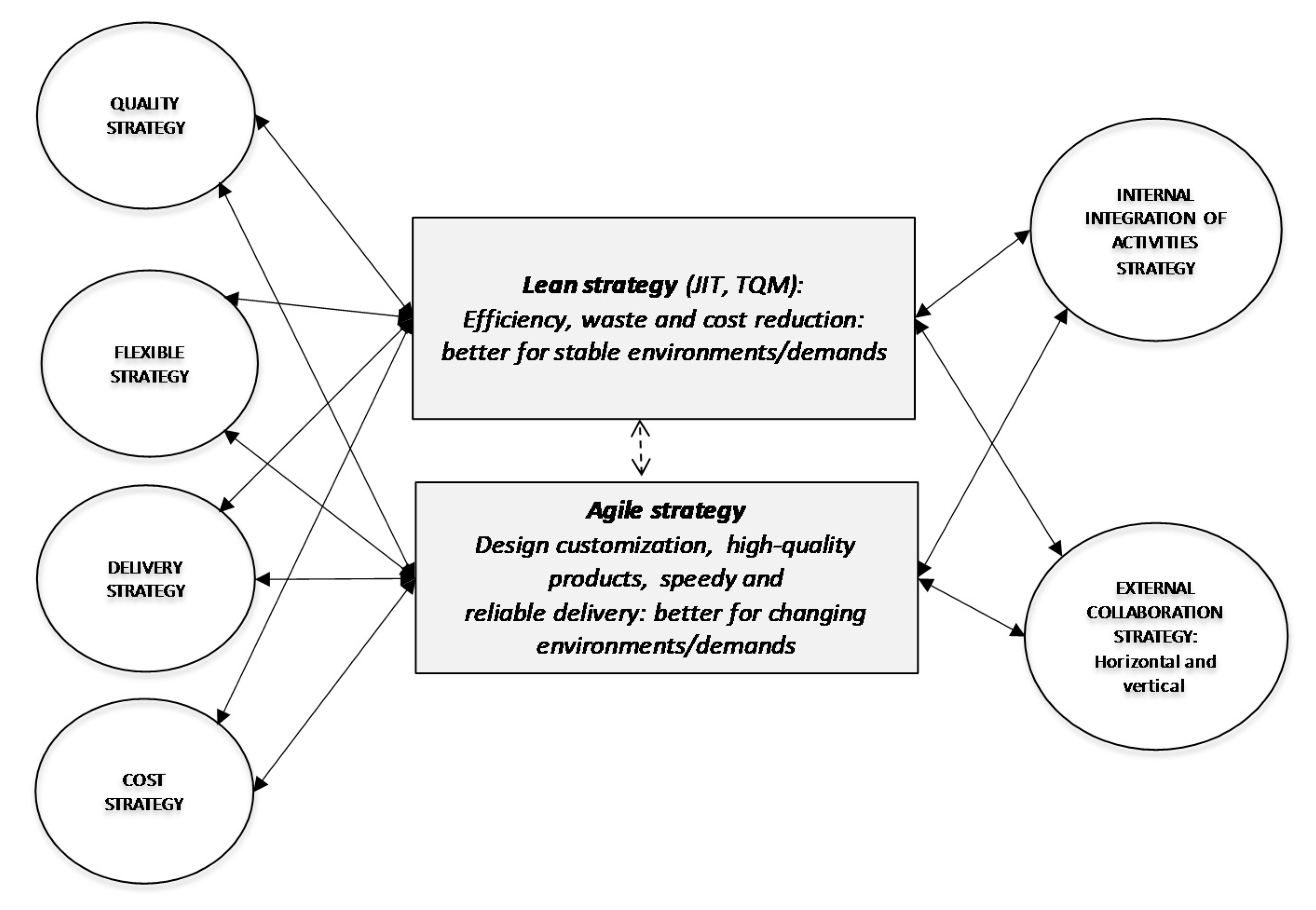
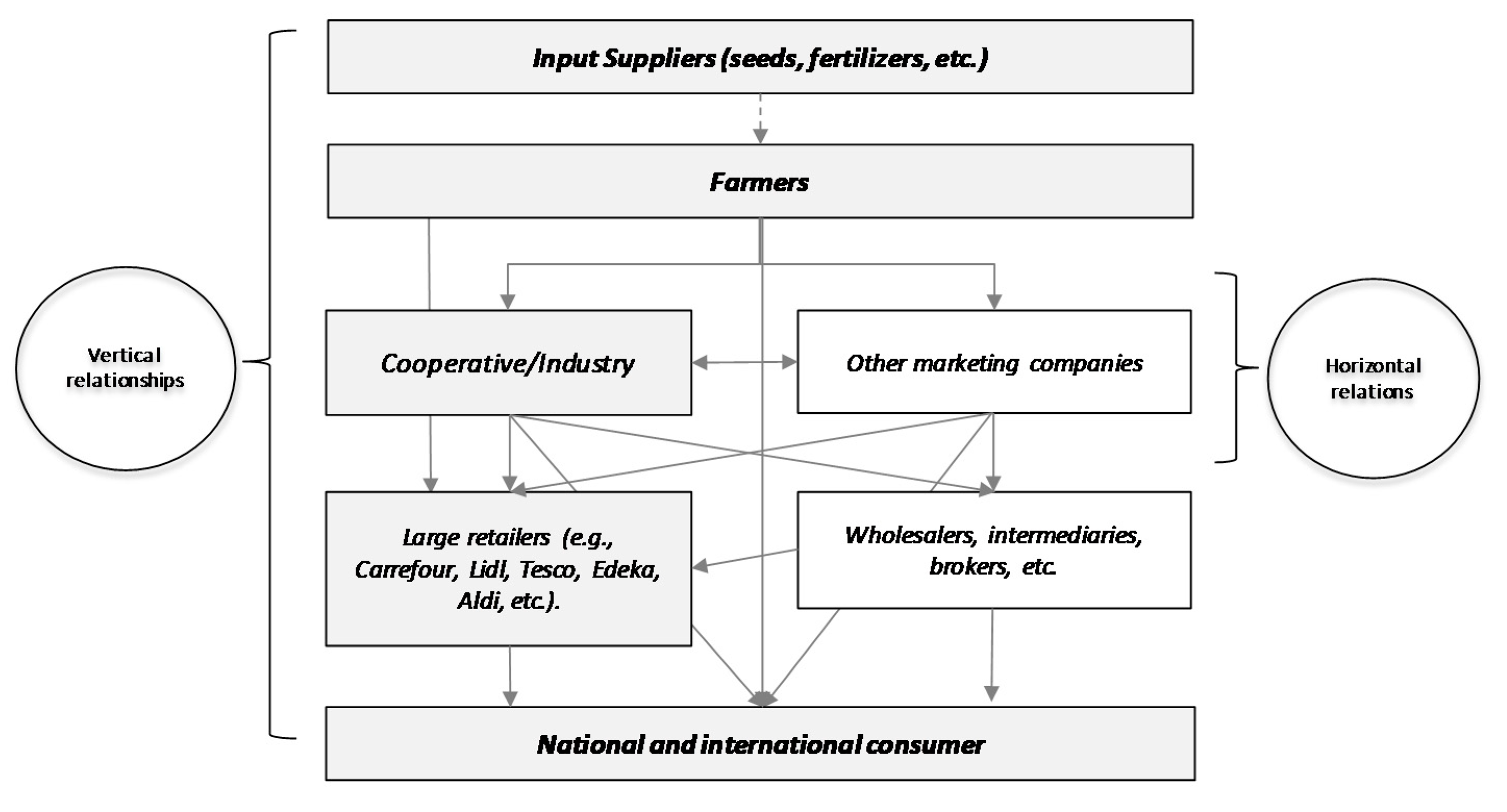
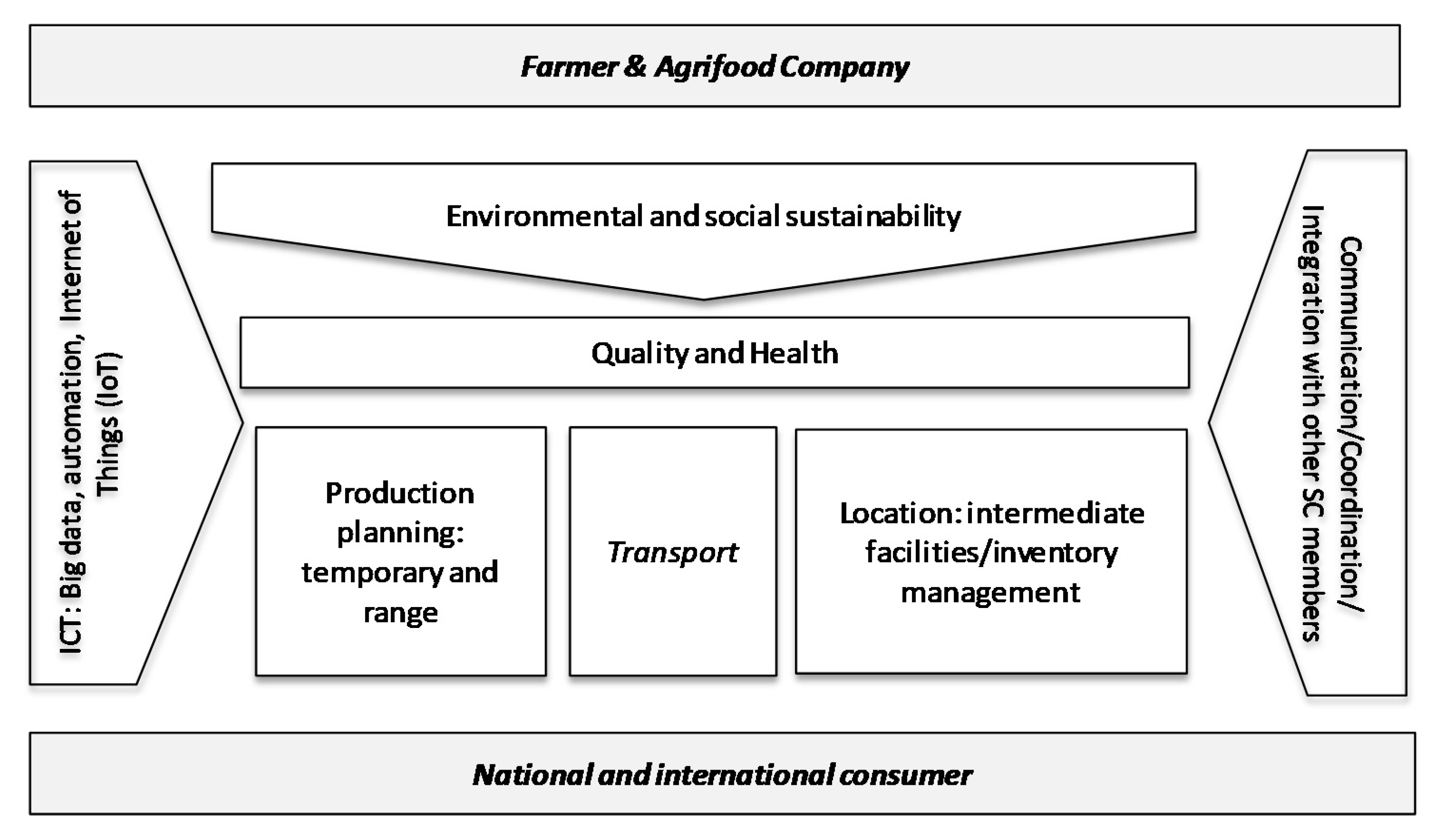
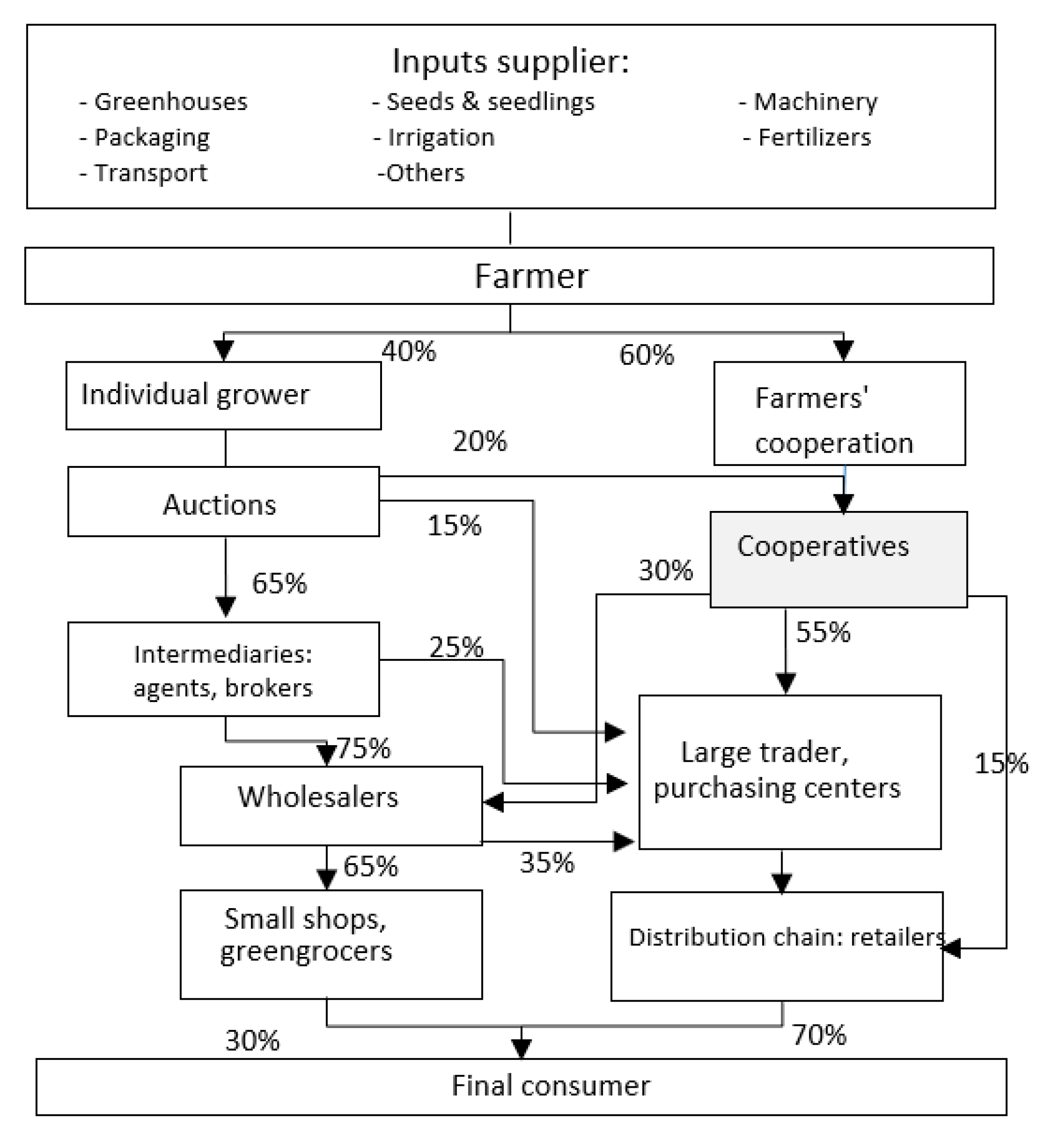
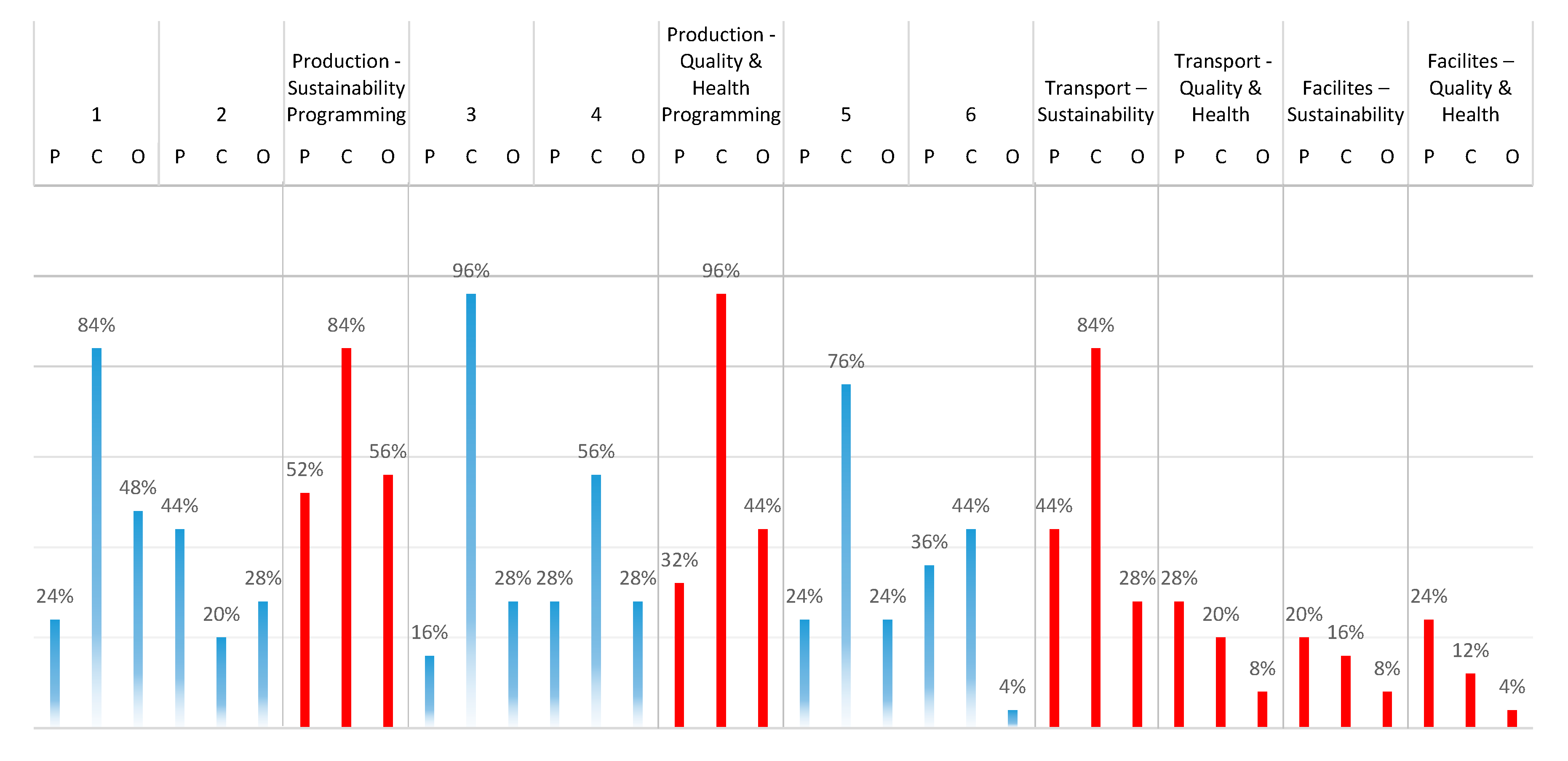
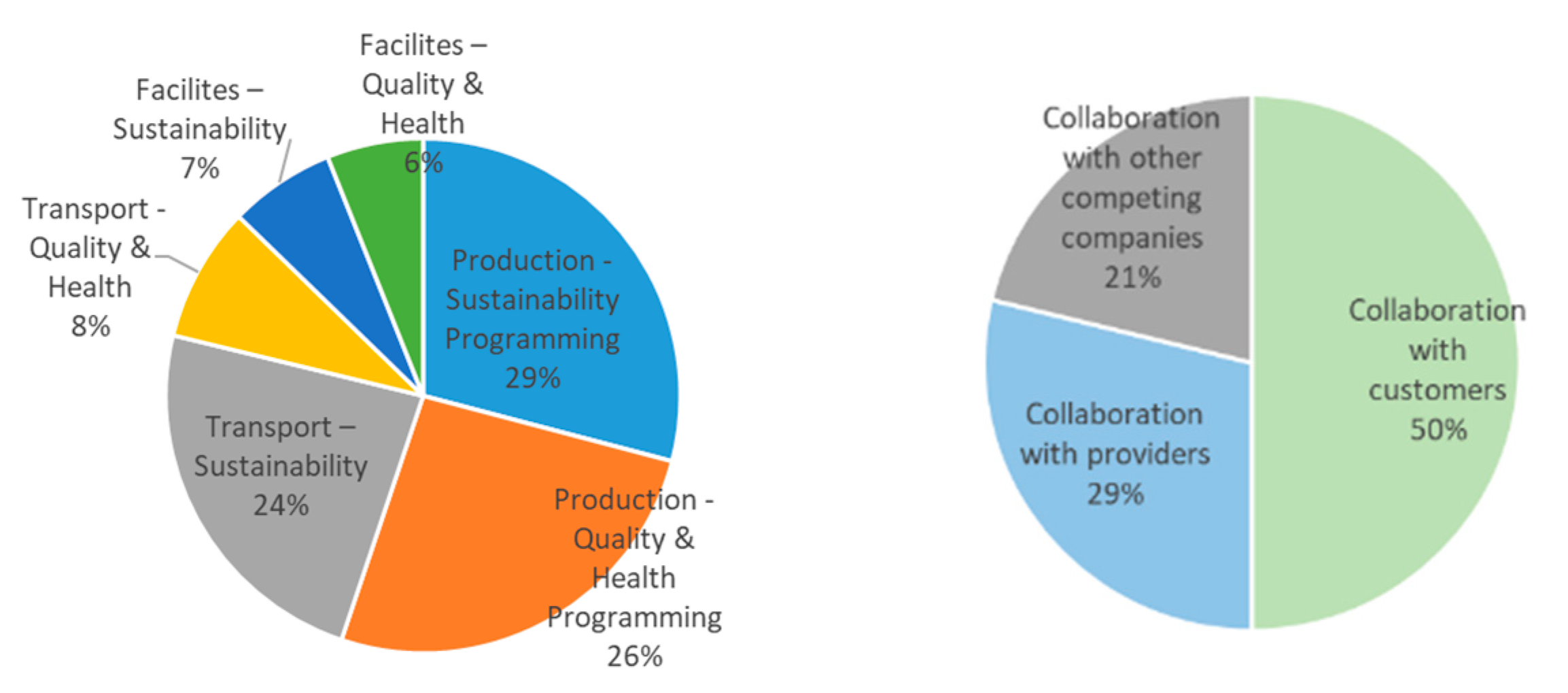
| Coordination–Collaboration–Communication Application of ICTs | ||||
|---|---|---|---|---|
| Sustainability | Quality–Food Safety | |||
| Vertical Relationship | Horizontal Relationship | Vertical Relationship | Horizontal Relationship | |
| Production scheduling |
|
|
|
|
| Transportation |
|
|
|
|
| Facilities |
|
|
|
|
| Cost Control | ||||
| Production—Sustain. | Production—Quality & Health | Transport—Sustain. | Transport—Quality & Health | Facilities—Sustain. | Facilities—Quality & Health | All Dimen. | |
|---|---|---|---|---|---|---|---|
| Intercept | −0.115 *** | −0.091 *** | −0.109 *** | −0.064 ** | −0.113 *** | −0.112 *** | −0.077 ** |
| P | 0.014 * | 0.013 * | 0.005 | 0.029 * | −0.001 | 0.019 | 0.008 ** |
| C | −0.014 | −0.015 | 0.006 * | −0.028 | −0.004 | −0.001 | −0.004 |
| O | −0.003 | −0.004 | 0.005 | 0.052 ** | 0.001 | −0.014 | 0.001 |
| Assets | 0.029 *** | 0.025 *** | 0.025 *** | 0.016 ** | 0.028 *** | 0.026 *** | 0.019 ** |
| Adj. R2 | 0.412 | 0.370 | 0.377 | 0.564 | 0.343 | 0.446 | 0.484 |
| F-Stat | 5.205 | 4.531 | 4.633 | 8.787 | 4.143 | 5.832 | 6.624 |
| χ2 (1) | 2.012 | 3.232 | 2.556 | 2.423 | 3.123 | 3.091 | 2.056 |
| W (2) | 7.631 | 5.261 | 4.561 | 7.265 | 6.644 | 8.213 | 5.972 |
Publisher’s Note: MDPI stays neutral with regard to jurisdictional claims in published maps and institutional affiliations. |
© 2021 by the authors. Licensee MDPI, Basel, Switzerland. This article is an open access article distributed under the terms and conditions of the Creative Commons Attribution (CC BY) license (http://creativecommons.org/licenses/by/4.0/).
Share and Cite
Pérez-Mesa, J.C.; Piedra-Muñoz, L.; Galdeano-Gómez, E.; Giagnocavo, C. Management Strategies and Collaborative Relationships for Sustainability in the Agrifood Supply Chain. Sustainability 2021, 13, 749. https://doi.org/10.3390/su13020749
Pérez-Mesa JC, Piedra-Muñoz L, Galdeano-Gómez E, Giagnocavo C. Management Strategies and Collaborative Relationships for Sustainability in the Agrifood Supply Chain. Sustainability. 2021; 13(2):749. https://doi.org/10.3390/su13020749
Chicago/Turabian StylePérez-Mesa, Juan Carlos, Laura Piedra-Muñoz, Emilio Galdeano-Gómez, and Cynthia Giagnocavo. 2021. "Management Strategies and Collaborative Relationships for Sustainability in the Agrifood Supply Chain" Sustainability 13, no. 2: 749. https://doi.org/10.3390/su13020749
APA StylePérez-Mesa, J. C., Piedra-Muñoz, L., Galdeano-Gómez, E., & Giagnocavo, C. (2021). Management Strategies and Collaborative Relationships for Sustainability in the Agrifood Supply Chain. Sustainability, 13(2), 749. https://doi.org/10.3390/su13020749








